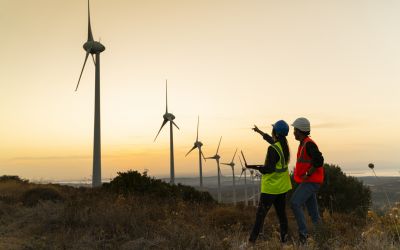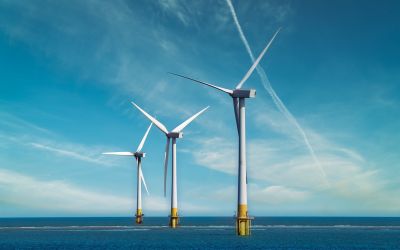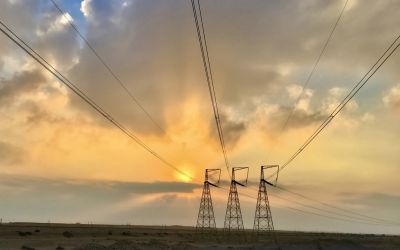Lesley Hunter on the importance of investors supporting U.S. climate targets to drive net zero
Lesley Hunter from ACORE talks to Climate Action about how the U.S. renewable energy sector continues to signal mature and resilient growth, but to achieve climate commitments and President Biden’s goal of a carbon-free grid by 2035, annual capacity additions will need to roughly double.

Ahead of the Sustainable Investment Forum North America, Lesley Hunter from ACORE talks to Climate Action about how the U.S. renewable energy sector continues to signal mature and resilient growth, but to achieve climate commitments and President Biden’s goal of a carbon-free grid by 2035, annual capacity additions will need to roughly double.
What are the current problems with corporate climate disclosures and when do expect to see a standardized framework being adopted across the US?
The inconsistency of standards across corporate sustainability disclosure frameworks has led to uneven reporting of climate information, resulting in sustainability investments that do not always result in direct greenhouse gas (GHG) emission reductions. Investors need more consistent, comparable, transparent and forward-looking corporate disclosures they can evaluate objectively to make the most meaningful impact on climate.
The Task Force on Climate-Related Financial Disclosures (TCFD) has emerged as a leading framework for investors and companies seeking to identify and disclose information on their climate-related risks and opportunities. Voluntary disclosure frameworks and other participants in the climate disclosure landscape are beginning to align with the TCFD’s recommendations, demonstrating a willingness for further collaboration around one set of generally accepted guidelines on climate disclosure. While its recommendations lack some specificity, the TCFD principles are nevertheless the most developed option.
Governments internationally have begun processes to regulate corporate sustainability disclosures – some inspired by or fully adopting the TCFD framework. In the U.S., President Joe Biden signed an Executive Order in May that directs a whole-of-government approach to climate-related financial risk. The U.S. Securities and Exchange Commission (SEC) Chair Gary Gensler has requested his staff draft a proposed rule for corporate climate disclosures informed by the TCFD recommendations by the end of this year. There are signals that a broader standard-setting process on Environmental, Social and Governance (ESG) disclosures could follow. Treasury Secretary Janet Yellen also said she would lead a regulatory review at the Financial Stability Oversight Council to investigate climate-related risks and improve climate-related financial disclosures, among other anticipated actions from U.S. government agencies in response to the Executive Order.
Climate disclosure is an important part of ESG investing. The potential allocation of ESG funds to renewable energy investment presents an opportunity to enhance the growth of climate-friendly energy resources. ACORE has been working with its membership, which spans investors, developers, utilities and public companies, to increase standardization, transparency and use of material indicators in ESG disclosure and scoring methodologies while better reflecting renewable energy use and investment. In order to mitigate the worst impacts of climate change, it is our view that the time is now for the U.S. to act on climate-related disclosures.
With the Biden administration do you expect to see an upsurge in renewable energy projects in the region and what are the likely challenges?
The U.S. renewable energy sector continues to signal mature and resilient growth, installing a record 33.2 gigawatts of renewable energy and attracting $55.1 billion in private sector investment in 2020, despite last year’s policy headwinds and uncertainties related to the pandemic. However, to achieve our country’s climate commitments and President Biden’s goal of a carbon-free grid by 2035, annual capacity additions will need to roughly double. Along with a direct pay option for monetizing renewable credits, investors tell us that capital will be ready to finance this additional climate-driven deployment if there is clear government support that drives demand for renewables and accelerates the closure of existing fossil-fired generation.
In that regard, Congress is now considering legislation that could create longer-term incentives for renewable generation, energy storage and regionally significant transmission. The administration’s strong focus on climate is also spurring new funding programs, regulations and targets to help propel the renewable sector forward.
In your opinion how important is it for investors and the financial industry in general to support U.S. climate targets and drive the energy transition?
Financial institutions are increasingly motivated by climate change and ESG considerations. All 10 major North American banks have set net-zero or Paris-aligned targets within the past year.
Achieving Paris targets will not be possible without eliminating emissions from coal power plants and halting further production of fossil fuels. Financial institutions are setting targets to divest from fossil generation, but their investment in this sector is still outpacing divestment, with fossil fuel bond underwriting by big banks rising 50% from 2019 to 2020.
According to BloombergNEF’s latest New Energy Outlook, the U.S. needs between $20.5 trillion and $28.5 trillion of investment in renewable energy by 2050 to reach net-zero emissions. It is imperative that financial institutions continue to scale up their climate commitments, divest from fossil fuels and invest in climate-friendly solutions like renewable energy to realize a more sustainable future.
How big the energy storage industry in the US is and what climate benefits does it bring?
Energy storage has the potential to fundamentally change the way we think about energy. In 2020, private sector investment in the U.S. energy storage sector passed $1 billion for the first time, but this is still a fraction of the investment seen in the more established solar and wind industries. Clean energy investors and developers expressed an extremely confident outlook for U.S. energy storage over the next three years in a survey conducted by ACORE this May, and investors ranked it as the most popular preference for investment alongside utility-scale solar compared to other clean technology sectors. The proposed federal tax credit for energy storage would have a transformative impact in realizing its potential, further promoting private sector investment and helping monetize the value of energy storage technology.
Energy storage pairs well with intermittent resources like solar and wind generation to create a stable and predictable source of clean power that can be available 24/7. Storage solutions can thus serve as viable replacements to traditional sources of power generation and result in lower costs and reduced conventional air pollution and GHG emissions.
Lesley Hunter is speaking at the Sustainable Investment Forum North America during Climate Week NYC from September 21, you can join her by registering here today.





